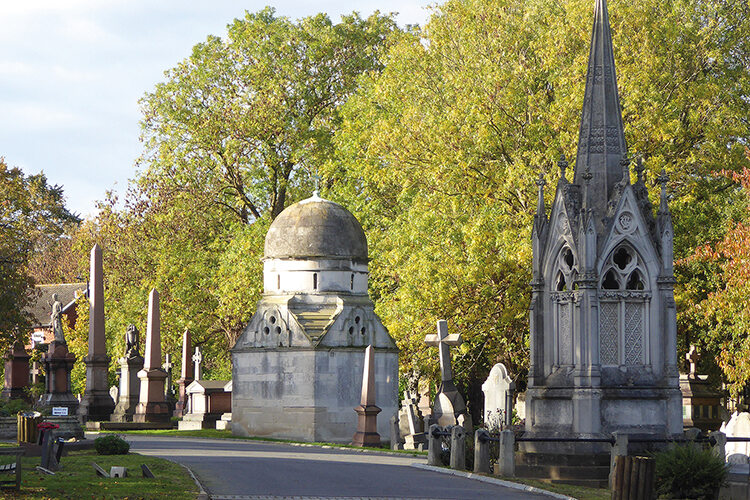
Rory Walsh explores West Norwood cemetery, one of London’s ‘Magnificent Seven’ cemeteries
Discovering Britain
Walk • Urban • Greater London • Web Guide
According to local lore, during the Victorian era, a coffin from West Norwood Cemetery was found bobbing in the Thames. When the cemetery owners identified it, they discovered that the grave lay undisturbed. The coffin had apparently dropped, then been carried underground through Brixton to the Thames at Vauxhall by the River Effra. ‘It’s a nice story,’ says Jane Jordan, ‘but I doubt it. The coffin would have got pretty bashed about. And would it even have floated?’
Jordan is an academic who specialises in Victorian literature and culture. She’s also a Friends of West Norwood Cemetery (FoWNC) member and leads guided tours of the site. In 2011, the FoWNC helped to create this Discovering Britain walk. A dozen years later, Jordan shows me a recent addition to the route.
It’s a November morning, with a pale blue sky above and orange and brown leaves on the ground. Everything is coated with the shiny film of recent rain, including a small plaque in the cemetery’s main path. It reads: ‘The Hidden River Effra Is Underneath Your Feet’. The river isn’t alone. West Norwood Cemetery is the final resting place of around 165,000 people.
Surrounding us are memorials of all shapes and sizes. There are Celtic crosses, Egyptian obelisks and mini-Roman temples. From the cemetery’s grand entrance arch, the walk visits around 30 notable graves. Along the way, we pass countless cherubs, scrolls, doves, draped urns and several mausoleums as big as garages. All human death is here. Jordan explains how and why.
‘For centuries, people were buried in their local parish churchyard. By the 1830s, London’s population was soaring and the city was running out of burial space. Plots were being reused. This created problems with public health, especially for the inner-city poor living near densely packed graveyards. There were also serious concerns about bodies contaminating water supplies, such as local springs. Something had to be done.’
From 1833, a series of large private cemeteries were created on London’s then outskirts. Besides West Norwood, the others were Kensal Green, Highgate, Nunhead, Brompton, Abney Park and Tower Hamlets. With their expensive plots and elaborate memorials, they later became known as the Magnificent Seven. Opened in 1837 as the South Metropolitan Cemetery, West Norwood was the second to be built. It was also the first British cemetery to be designed in the Gothic Revival style.
At a fork in the path, the route gradually climbs uphill. Norwood’s name derives from the Great North Wood, an ancient forest that covered Croydon to Camberwell. West Norwood is within the upland of the Norwood Ridge and the cemetery capitalised on this natural hillside location. ‘The grounds were laid out like a pleasure garden,’ says Jordan. Long, winding paths led up to two Gothic chapels reminiscent of King’s College, Cambridge. Engravings and early photos depict the cemetery as a Victorian version of the Elysian Fields.
These bucolic surroundings encouraged visitors. West Norwood became a very desirable place to be buried. ‘It was known as the Millionaires’ Cemetery,’ Jordan continues. ‘Many of the burials were wealthy, self-made men.’
Scenic plots, such as on the hilltop, were sold as prime locations. Among the many striking monuments is that of John Wimble, a sea captain for the East India Company. Topping his grave is a stone model of a ship, which may originally have had masts and rigging. Nearby, the mausoleum of merchant draper Otto Berens is the size of a cottage. Imposing and ornate, it features angelic statues, Minton tiles and Sienna-marble columns.
Geological surveys would identify many rocks and minerals used in the monuments. Popular choices included white Carrara marble, blue Norwegian larvikite and red granite from the Ross of Mull. ‘That’s due to the railways,’ says Jordan. ‘By the 1850s, they made it much easier to transport materials from elsewhere, including overseas.’ Such ostentatious memorials reflect Victorian attitudes to death.
Another potent example of the times is on one of the simplest graves. A short way from the Berens mausoleum is a plain white headstone. It marks probably the most famous person buried at West Norwood: Isabella Beeton. First published in 1861, Mrs Beeton’s Book of Household Management has never been out of print, despite Isabella dying during childbirth, aged just 28. The inscription on the family grave lists Isabella halfway down as the ‘wife and fellow worker’ of her husband Samuel. ‘For even the most successful women, Victorian society was very patriarchal,’ Jordan summarises. ‘In death as in life.’
When I first visited West Norwood, the Beeton headstone was black with dirt. It has since been cleaned and restored. So have the Berens mausoleum and numerous others. The FoWNC’s efforts have helped to identify and repair many of the historic graves. Some aren’t so pristine. During the walk, we pass areas crowded with headstones and sections that are much emptier. Many of the old monuments are broken. Others are missing entirely.

The cemetery companies made money from selling plots until, inevitably, there were none left. Deprived of their main source of income, the South Metropolitan company struggled to maintain West Norwood. The site fell into disrepair and in 1965, it was compulsorily purchased by Lambeth Council. The problem of the previous century resurfaced. Short of new burial space, the council controversially – and illegally – removed thousands of headstones. Around 1,000 new graves were then put in over the earlier ones.
West Norwood Cemetery is now technically full; however, burials still take place in existing family plots, as do cremations and memorial services. Past the crematorium, it’s soon apparent how the local area has evolved. Many of the later headstones feature international names and inscriptions. Besides eminent Victorians, the walk visits the graves of post-Second World War migrants, including Brixton market trader Oswald Denniston, who arrived in Britain on the Empire Windrush.
An earlier generation of migrants also shaped West Norwood. The spectacular Greek Enclosure (or Necropolis) comprises a dizzying collection of tightly packed monuments and mausoleums. Several were built for Greek merchants and shipping magnates whose businesses had London interests. Many of these wealthy families emigrated to London to seek refuge from brutal Ottoman reprisals following the Greek War of Independence. In 1842, they acquired a large area of the cemetery for Greek Orthodox burials.
Dominating the Necropolis is St Stephen’s Chapel, built by merchant Stephen Ralli. During our visit, scaffolding was being removed from
its Doric columns. In 2019, West Norwood Cemetery was awarded National Lottery Heritage Funding to help repair its 69 listed monuments and structures. The grounds are being renovated, with plans underway for new pedestrian entrances and a visitor centre. The restored St Stephen’s Chapel is set to become a ‘community space’ for local events.
From the Necropolis, we return to the cemetery’s main entrance. The path has dried and we find another River Effra plaque. It’s now lunchtime. A young woman pushes a pram past us. Traffic trundles along the road outside. Before leaving, Jordan and I read some more of the headstones. All those people, all those lives. Who were they? All human life is here.




